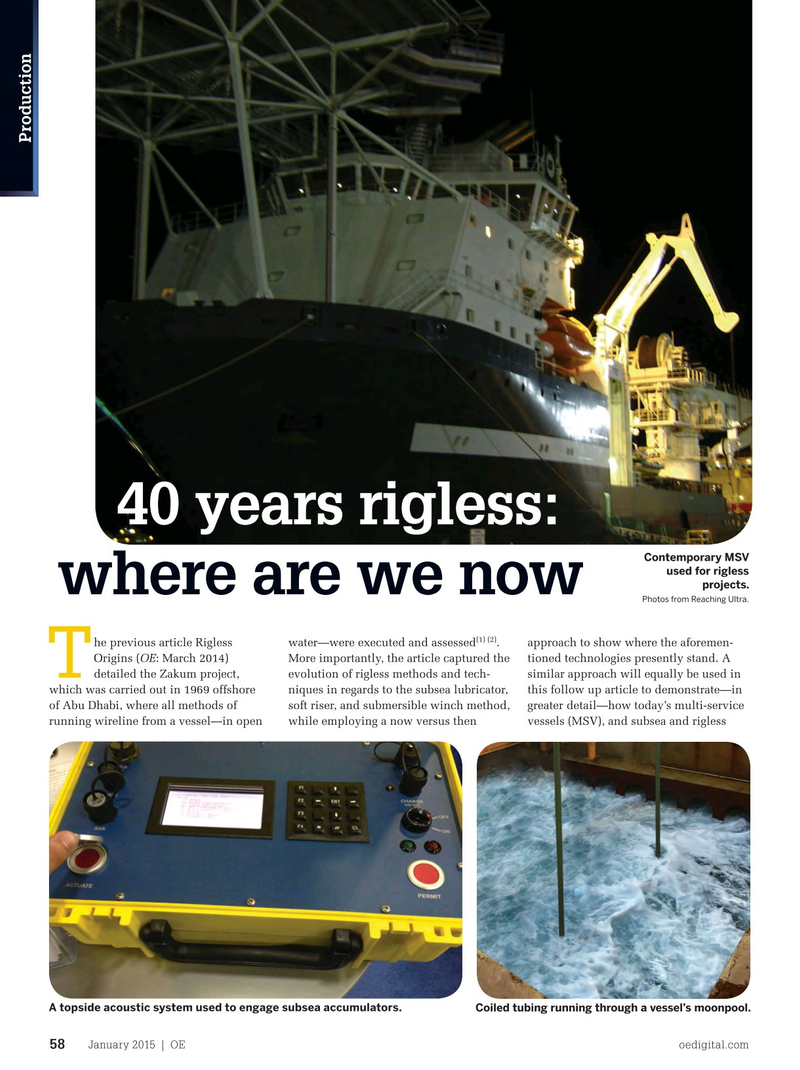
Page 56: of Offshore Engineer Magazine (Jan/Feb 2015)
Read this page in Pdf, Flash or Html5 edition of Jan/Feb 2015 Offshore Engineer Magazine
intervention equipment/methods have evolved to meet the demands of contem- porary rigless light well interventions (RLWI).
EyebrowProduction
Size disconnecting: vessel comforts
One of the key fndings made at Zakum was the need for “larger and better equipped [vessels to conduct] opera- tions in deeper water and more exposed (2) areas” . Comparatively speaking, today’s
MSVs are better suited for such deepwa- ter environments as exemplifed by their use at depths in excess of 3900ft when (3) operating in a rigless fashion . Conversely, the forward bridge dive vessels—Sharifah and Ajax—used at
Zakum operated at very shallow water (1) (2) depths . In spite of these advances, today’s MSVs must contend with hav- ing to keep station during deepwater operations (Station keeping was also a concern at Zakum). Furthermore, a glitch on an MSV’s station keeping system can cause it to lose station, leading to a drive off, resulting in brash and uncontrolled tugging of topside to subsea conduits that tether a vessel to a 40 years rigless: fxed subsea point.
Protective measures to prevent tug-
Contemporary MSV ging is key, which is due to the fact used for rigless that these conduits make it possible projects. where are we now to intervene and communicate with a
Photos from Reaching Ultra.
well, without a marine riser. For this reason, it is of the utmost importance (1) (2) he previous article Rigless water—were executed and assessed . approach to show where the aforemen- that conduits have the ability to disen-
Origins (OE: March 2014) More importantly, the article captured the tioned technologies presently stand. A gage—in an emergency, independent
T detailed the Zakum project, evolution of rigless methods and tech- similar approach will equally be used in of a remotely operated vehicle (ROV), or an intervention workover control which was carried out in 1969 offshore niques in regards to the subsea lubricator, this follow up article to demonstrate—in system (IWOCS)—while facilitating of Abu Dhabi, where all methods of soft riser, and submersible winch method, greater detail—how today’s multi-service the following: Parting and sealing on running wireline from a vessel—in open while employing a now versus then vessels (MSV), and subsea and rigless
A topside acoustic system used to engage subsea accumulators. Coiled tubing running through a vessel’s moonpool.
January 2015 | OE oedigital.com 58 058_OE0115_ProdOps1.indd 58 12/22/14 4:50 PM

 55
55

 57
57